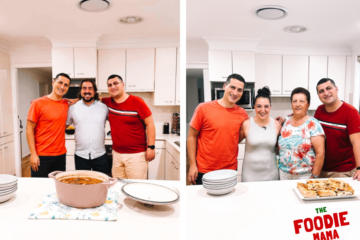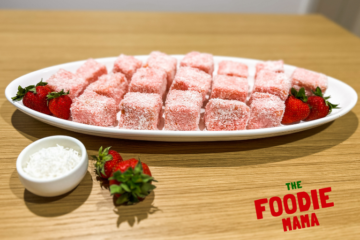For me, food is a love language. Food is love. Food is a very powerful way of creating a connection and expressing love. There is nothing more that brings me joy than seeing my loved ones enjoying a meal I’ve prepared with so much love. Food is a recipe for long-lasting love. Love, love, love… It’s Valentine’s Day and I can’t think of anything better to celebrate this day than with food!
A trend I’ve seen pop up on socials is a word mash-up of l-imħobża. It is the word imħabba (love) and ħobża (bread) put together to name a heart shaped bread made and sold by Maypole in Malta around the time of Valentine’s Day. I love the creativity of mashing the two words together and just had to get on the band wagon.

Taking inspiration from Maypole’s imħobża, I want to share with you my quick and easy no-knead Maltese bread (ħobż Malti) recipe. Traditionally, Maltese bread is a sour dough. This recipe doesn’t use a starter so technically not a sour-dough bread, but you still get a light fluffy middle and a crusty crunchy outside like a Maltese bread.
Ħobż Malti dates back to the Phoenician period and is known for being round in shape, it has a dark outer crust and a soft, airy interior. Another popular type of bread is the ftira, from the verb fattar – meaning to flatten (the dough). The ftira is made of the same ingredients as the ħobż Malti however, it is flat in shape and has a hole in the middle. Like the ftira, Maypole’s imħobża is heart-shaped with a void in the middle. My take on the bread is just the traditional loaf style bread, shaped into a heart. I tried scoring a heart in the middle hoping to create a nice rise/shape but I think I scored it at the wrong time. Nevertheless, the recipe makes for a bread as close to the real deal that is ħobż Malti.
Maltese style no-knead crusty bread
This is best baked in a Dutch oven. Why? A Dutch oven conducts heat evenly for consistent baking, and has a heavy lid that traps any steam released by the bread while it cooks. The key to getting that Maltese crusty outside? Steam!

Photo by: Charmaine Tokic
Ingredients
- 9g active dry yeast
- 1 tsp sugar
- 1 ¼ cups warm water
- 400g all purpose flour (and a little extra for dusting)
- 8g salt
Method
Mixing the dough & first rise
- Combine the yeast, sugar, and warm water in a large mixing bowl and allow the yeast proof for about 5 minutes, until the mixture bubbles and is foamy.
- Add flour to the bowl by way of sifting and mix with a sturdy spatula until the dough starts to come together, then add the salt until no dry bits of flour remain. The dough is a wet and sticky dough, it will become more smooth and elastic as you go.
- Cover the bowl with a clean tea towel and leave to rise for 1 hour. I find placing the bowl in a warmer room in the house works best.
Shaping the dough & final rise
- When the dough has risen (it should have doubled in size), lightly flour your kitchen bench.
- Tip the bowl upside down and let the dough fall out on its own. Try not to pull the dough out, you want to keep all those nice air bubbles intact so that it’s nice and airy.
- Shape the dough into a round loaf: Pull each corner of the dough in towards the center (like you’re folding an envelope) and repeat until the dough feels tight and begins to resist your folds. This is where you’ll notice the dough going from a sticky dough to a nice smooth dough. Flip the dough over and pull it into a round loaf.
- Flour a proofing basket or a medium sized bowl and place the dough seam-side down. Cover with a tea towel and let rise another 30 minutes while you preheat the oven at 240°C. I like to place the Dutch oven in to preheat also in this time.

Time to bake!
- Lay a piece of baking paper on your kitchen bench. This will make transferring the dough into the Dutch oven easier.
- Tip the dough gently out of the proofing basket onto the baking paper, ensuring the seam side is up this time – this is what will create those crunchy cracks on top of the bread.
- Sprinkle with some flour on top.
- Bake the bread for 30 minutes with the lid on, then remove the lid from the Dutch oven.
- Continue cooking the bread uncovered for 15-20 minutes or until the bread has deepened in color and you have a crunchy brown crust.
- Remove the bread from the Dutch oven and place on a cooling rack. Allow to cool before cutting into it.

Photo by: Charmaine Tokic
Tips:
- Don’t overmix the dough in your initial mix of flour and water yeast mixture. If you overmix, you’ll have less bubbles/airiness in your loaf.
- As mentioned, this is a very wet dough – the dough should feel sticky when mixed. This dough should NOT pull away from the sides of a bowl into a smooth, elastic ball like other recipes you may have used. Don’t worry – it will become more elastic as gluten develops while the dough rises.
- If you wanted to score a design on top of your loaf, its best done after 5-10 minutes after your initial placement in the oven. I failed this time round, but hope to master it each loaf I make.
- When folding the dough in like an envelope, try to do it as gently as possible. This is where we can create more air bubbles!
If you would like to read about a particular foodie topic feel free to drop me a line via editor@thevoiceofthemaltese.org or direct message me on my Instagram @_thefoodiemama



